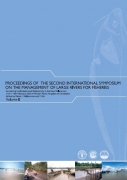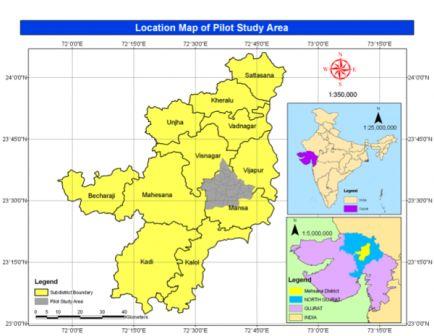/sub-categories/presentations
Presentations
Pampa Sarovara and its environs in Valmiki Ramayana - Paper presented at the National Seminar on Water and Culture (2007)
Posted on 14 Feb, 2011 03:17 AMThis paper describes a lake in one of the forests through which the Hindu god Ram and his brother Laxman passed, during their search for Sita. A virtual picture of the forest and the lake (Pampa Sarovara) in it using the Valmiki Ramayana which is a religious biopic of Ram's life on earth is created. This lake is situated near the town of Hampi in Karnataka today, and the forest is a rich source of water to this day.
Water management in the Vijaynagar empire - Paper presented at the National Seminar on Water and Culture (2007)
Posted on 14 Feb, 2011 01:55 AMThis paper focuses on water management techniques used in two tanks constructed by the kings of the Vijaynagar Empire.
The first example taken, is that of the Anantraj Sagar built by the son of the minister of Harihar. The lake is still in use and there are inscriptions on stone near it which provide a thumb rule to constructing lakes. Construction of this lake began in 1369 and was completed in 2 years. The paper states that the length of the dam was 5000 dand, width was 8 dand and the height was 7 dand (One dand is about one metre).
Water management systems in the coastal area of Ratnagiri, with special reference to water tanks near temples - Paper presented at the National Seminar on Water and Culture (2007)
Posted on 14 Feb, 2011 01:27 AMThis paper discusses the water management systems found in temples in coastal Konkan, based on a study of 5 temples in the district of Ratnagiri. The study area is a rocky and rugged country, with elevated plateau and intersecting creeks.

Ideal historical river water use systems - Paper presented at the National Seminar on Water and Culture (2007)
Posted on 14 Feb, 2011 12:02 AMThe Phad system of irrigation which has been going on for centuries, is found in the northwestern parts of Maharashtra in the three river basins of Panjhra, Mosam, Kan and Aram. Weirs were constructed on these rivers to divert water for agriculture use. These weirs are locally called Bandhara. Each independent Phad system comprises of a diversion weir, a canal on the bank and distributor channels for irrigation.
Proceedings of the second international symposium on the management of large rivers for fisheries by FAO and Mekong River Commission
Posted on 03 Feb, 2011 07:55 PM The second international symposium on the management of large rivers for fisheries was held by the Food and Agriculture Organisation of the United Nations (FAO) and Mekong River Commission on 11 - 14 February 2003 in Phnom Penh, Kingdom of Cambodia. It had three primary objectives: (a) To provide a forum to review and synthesise the latest information on large rivers; (b) To raise the political, public and scientific awareness of the importance of river systems, the living aquatic resources they support and the people that depend on them; and (c) To contribute to better management, conservation and restoration of the living aquatic resources of large rivers.
The second international symposium on the management of large rivers for fisheries was held by the Food and Agriculture Organisation of the United Nations (FAO) and Mekong River Commission on 11 - 14 February 2003 in Phnom Penh, Kingdom of Cambodia. It had three primary objectives: (a) To provide a forum to review and synthesise the latest information on large rivers; (b) To raise the political, public and scientific awareness of the importance of river systems, the living aquatic resources they support and the people that depend on them; and (c) To contribute to better management, conservation and restoration of the living aquatic resources of large rivers.
The symposium was organised in six sessions:
Session 1: Status of rivers
Session 2: Value of river fisheries
Session 3: Fisheries ecology and conservation
Session 4: Management of river fisheries
Session 5: Statistics and information
Session 6: Synthesis
It came up with the following recommendations for action -
- Improve the valuation of living river resources in order to contribute to equitable and sustainable management of fishery resources and properly place the fishery in the context of the other uses of rivers.
- Direct greater effort to better understanding the social and economic aspects of fisheries to support policy and management priorities; livelihood approaches will be a valuable tool.
- Communicate and engage with environment and water resources managers within the context of multi-use of water in order to accurately assess impacts and to sustain the benefits of river fisheries in an equitable manner.
- Develop processes that facilitate the users and beneficiaries of the fishery resource to assume greater control of its management.
- Establish appropriate mechanisms at national and basin level to enable negotiation for the needs of communities dependent upon the living aquatic resources. In particular further regulations need to be elaborated to protect general ecosystem function and provide for environmental flows.
- Use instruments such as the freshwater eco-regions approach, the Ramsar Convention and the guidelines for water allocation suggested by the World Commission on Dams, to enhance planning for conservation and sustainable use of river habitats.
- Incorporate ecological flow requirements of river-floodplain systems into development plans and impact assessments that affect river flows, taking into account the seasonality of the system and the environmental cues needed by the fish for migration and reproduction.
- Rehabilitate degraded ecosystems wherever possible. Prioritize schemes that ensure connectivity and protection of critical habitats.
Conjunctive use of surface water and ground water - Lecture delivered by Dr. R. Jagadiswara Rao at National Water Academy, Pune
Posted on 03 Feb, 2011 12:09 PM
Dr. R. Jagadishwara Rao
Former Professor of Geology
Sri Venkateswara University
Tirupati, AP 517502
India's participation at the UN Climate Change Conference at Cancun, Mexico - MoEF press release and ninister's statement
Posted on 31 Jan, 2011 12:16 AMContent Courtesy: Ministry of Environment and Forests, Government of India
Press release: Indian event at Cancun re-emphasises importance of equity, 7th December 2010
India hosted a major event at the sidelines of the UN Climate Change Conference at Cancun, where the critical issue of equity and equitable access to carbon space was emphasised.
India's Minister for Environment and Forests and Head of Delegation, Shri Jairam Ramesh personally chaired the side event that had presentations by Prof. T. Jayaraman, Tata Inst. Of Social Sciences, India, Mr. Martin Khor, Executive Dir., South Centre, Geneva and Dr. Harald, ERC & Univ. Of Cape Town, South Africa.
Download the entire press release here.
The worsening water crisis in Gujarat - The Earth Institute
Posted on 20 Jan, 2011 04:41 PMIt was the kick-off event of an ambitious project to find solutions to the groundwater crisis in Gujarat, funded by the PepsiCo Foundation. More details of the project will follow this overview post.
 Gujarat and the Mehsana region, India Source: Columbia Water Center
Gujarat and the Mehsana region, India Source: Columbia Water Center
Whose water? Privatisation of water, a bane for consumers
Posted on 18 Jan, 2011 11:47 PMAll of us have felt the joy of slaking one's thirst with water, washing away the unforgiving heat of a Delhi summer with a cool glass of water. But have you ever paused to think about where we get our water from? How are we using this resource? Is it finite or will be always get clean water, everyday, for all our needs?
Managing Natural Resources -A report by IDSAsr
Posted on 18 Jan, 2011 04:24 PMThe scarcity value of natural resources has risen due to rising pressure of human population and demands made by modern economics progress. As such managing these resources has become very important.